Figures & data
Figure 1. Satellite image of the area near Gözükızıllı village with the two sites where fossil rodents have been collected. Image from Google Earth, date 19/06/2020, copyright 2020 CNES/Airbus, 2020 Google, 2020 Basarsoft
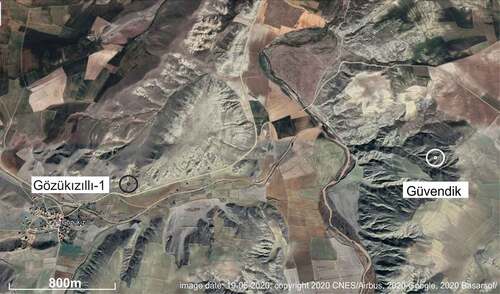
Figure 2. Nomenclature of tooth parts of Daxneria nov. gen. described in this paper (adapted after Flynn et al. Citation1986).

Figure 3. Upper cheek teeth of Daxneria fragilis nov. gen. nov. sp. (a-j) and Sayimys sp. (k) from Gözükızıllı-1, occlusal, lingual or antero-lingual view. Daxneria fragilis: a & e GOZ1b-237, b GOZ1a-195, c GOZ1b-233, d GOZ1b-277, f & g GOZ1b-228, h upper incisor, no number, i & j GOZ1a-199. Sayimys sp.: k GOZ1b-251

Figure 4. Lower cheek teeth Daxneria fragilis nov. gen. nov. sp. and Sayimys sp. (lower row) from Gözükızıllı-1, occlusal and labial views. Daxneria fragilis: a & e GOZ1a-219, b GOZ1b-247, c & f GOZ-1b-248, d & g GOZ1b-241, h & i GOZ1a-220, j & k GOZ1a-202, l lower incisor no number. Sayimys sp.: m & n GOZ1b-253, o & p GOZ1b-252
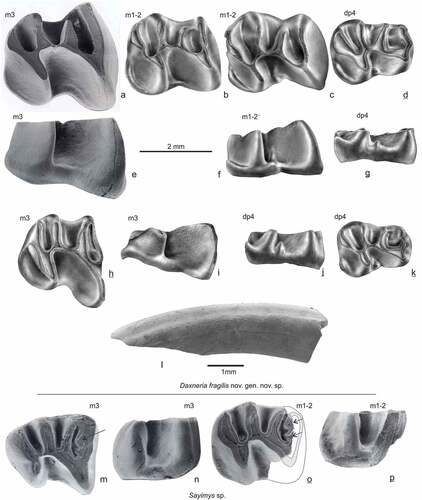
Figure 5. Sections of the lower incisor of Daxneria fragilis nov. gen. nov. sp. a-c transverse sections; b enlargement of square in a, c enlargement of square in b. d-f sagittal sections: e enlargement of square in d, f enlargement of square in e

Table 1. Measurements of Daxneria fragilis nov. gen. nov. sp. from Gözükızıllı-1a and 1b; shown are minimum, maximum, mean, number of observations and standard deviation
Figure 6. Upper and lower cheek teeth of Baluchimys ganeshapher (a, b, c, d, m, n, o, p), Baluchimys barryi (l, f, g, h, q, r, s, t) and Lindsaya derabugtiensis, all three from site Y-GSP417 (Flynn et al., Citation1986). The bar represents 1 mm; the approx. enlargement has been added
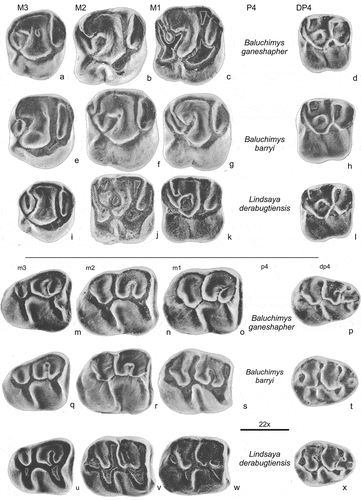
Figure 7. Comparison of upper cheek teeth of Daxneria fragilis (v-y) with Bugtimys Marivaux et al., Citation2002 site Paali nala C2 (a-e), Hodsahibia Marivaux & Welcomme Citation2003 site Paali nala C2 (f-h), H. gracilis Paali nala C2 (j-m), Lophibaluchia Flynn et al., Citation1986 site Y-GSP417 (n-q) and Ottomania de Bruijn et al., Citation2003 site Süngülü. Daxneria, Ottomania and Lophibaluchia retained their DP4 and have no P4. The bar represents 1 mm; the approx. enlargements have been added, these are not the same
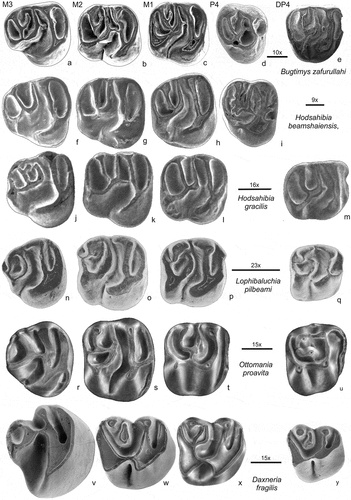
Figure 8. Comparison of lower cheek teeth of Daxneria fragilis with Bugtimys Marivaux et al. (Citation2002) site Paali nala C2, (a-e); Hodsahibia beamshaiensis Marivaux and Welcomme (Citation2003) site Paali nala C2, (f-h); H. gracilis Marivaux and Welcomme (Citation2003) site Paali nala C2, (i-k); Lophibaluchia Flynn et al. (Citation1986) site Y-GSP417, (l-o) and Ottomania de Bruijn et al. (Citation2003), site Süngülü, (p-s). Daxneria, Ottomania and Lophibaluchia retained their DP4 and have no P4. The bar represents 1 mm; the approx. enlargements have been added, these are not the same
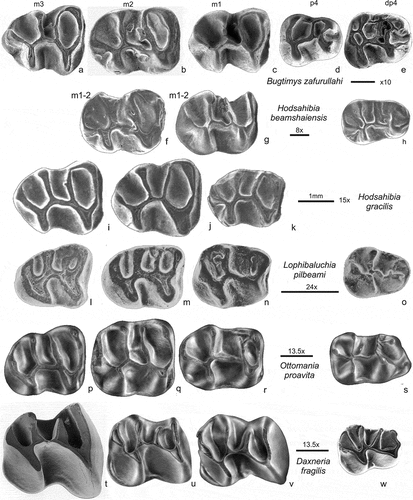
Figure 9. Comparison of Sayimys sp. from Gözükızıllı with Sayimys aff. obliquidens from the middle member of the Chul’adyr Formation Aktau Mountains, Kazakhstan (e-i) and S. flynni from Z113, Zinda Pir, Pakistan (j-m)
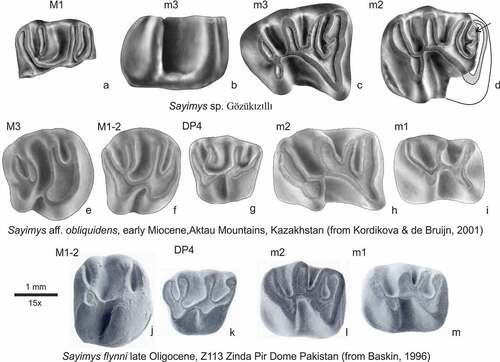
Table 2. List of species of Eucricetodon from Europe. The allocation into groups is after Freudenthal & Martin-Suarez (Citation2016)
Table 3. Eucricetodon species based on limited type material from unknown type localities and of uncertain age
Table 4. List of Asian Eucricetodon species
Figure 10. Length-width scatter diagrams of the molars of the two species of Eucricetodon from Gözükızıllı-1 (red points) and E. margaritae (black crosses) from Pareja. The line separates the Gözükızıllı points into E. oculatus nov. sp. and E. ruber nov. sp. The measurements of E. margaritae from Pareja have been digitised from Daams et al. (Citation1989, Figure 3)
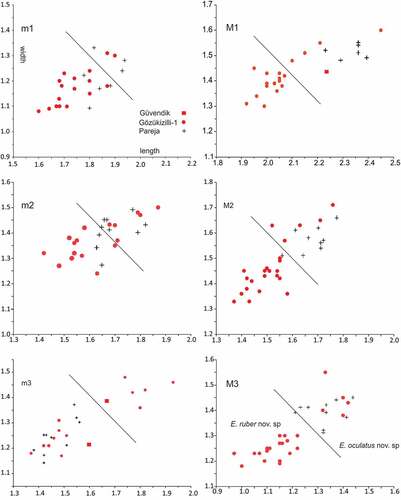
Figure 11. The length of M1 (range and average) of Eucricetodon from Gözükızıllı compared with that of late Oligocene and early Miocene species of Eucricetodon from Europe. For Bouzigues see Aguilar (Citation1974); for Cetina (de Aragon) see Daams (Citation1976); for Estrepouy see Hugueney & Bulot: for Fraga 4 see Augusti & Arbiol 1989; for Laugnac see Daams (Citation1976); for Mirambueno 4D see Freudenthal (Citation1994). for Oensingen, St-Victor-la-Coste and Pech-du-Fraysse see Vianey-Liaud (Citation1972); for Paulhiac, Boudry and Küttigen see Engesser Citation1985; for Pareja see Daams et al. (Citation1989); for Ulm & Weiss-6 see Dienemann (Citation1987)
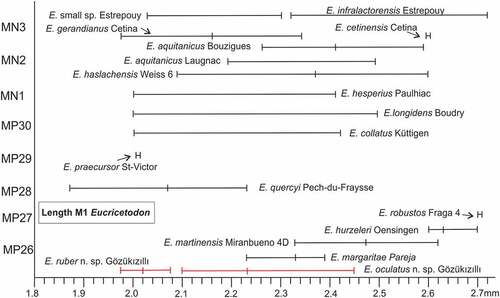
Figure 12. Nomenclature of parts of Eucricetodon molars (adapted after Mein and Freudenthal Citation1971b)
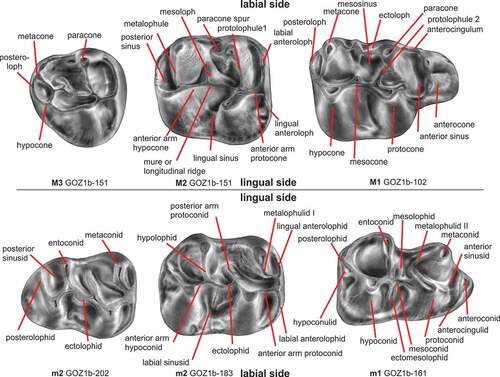
Figure 13. Upper molars of Eucricetodon oculatus, E. ruber from Gözükızıllı-1 and E. margaritae from Pareja (Spain). E. occulatus: a GOZ1b-151, b GOZ1b-131, c GOZ1b-102 holotype, d GOZ1b-141, e GOZ1b-121, f GOZ1b-111; E. ruber: g GOZ1b-156, h GOZ1b-126, i GOZ1b-106, j GOZ1b-144, k GOZ1b-128, l GOZ1b-105 holotype; E. margaritae: m-o
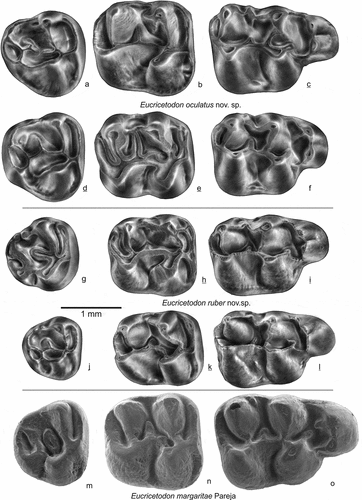
Figure 14. Lower molars of Eucricetodon oculatus,Eucricetodon oculatus, E. ruber from Gözükızıllı-1 E. ruber from Gözükızıllı-1 and E. margaritae from Pareja (Spain). E. oculatus: a GOZ1b-202, b GOZ1b-183, c GOZ1b-162, d GOZ1b-211, e GOZ1b-182, f GOZ1b-161; E. ruber: g GOZ1b-216, h GOZ1b-186, i GOZ1b-166, j GOZ1b-204, k GOZ1b-188, l GOZ1b-167; E. margaritae: m-o
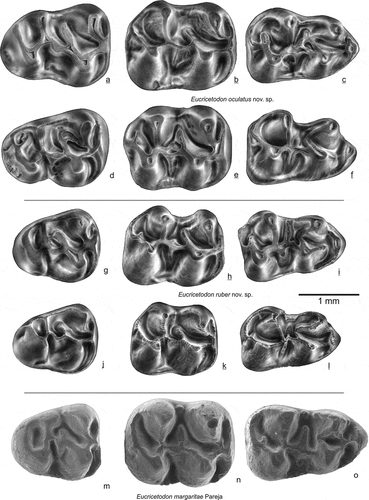
Table 5. Measurements of Eucricetodon ruber nov. sp. from Gözükızıllı-1 and Güvendik
Table 6. Measurements of Eucricetodon oculatus nov. sp. from Gözükızıllı-1 and Güvendik
Figure 15. Transverse sections (a-e) and sagittal sections (f-h) of the lower incisor of Eucricetodon from Gözükızıllı-1
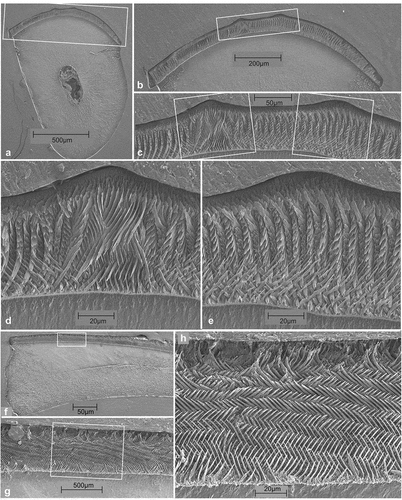
Table 7. Character states in upper molars of Eucricetdon ruber nov. sp. and E. oculatus nov. sp. from Gözükızıllı-1
Table 8. Schmelzmuster types of lower incisors in Eucricetodon samples. The allocation to group (grp) is after Freudenthal and Martín-Suárez (Citation2016)
Figure 16. The Dipodidae and Gliridae from Gözükızıllı: a Dipodidae gen. et sp. indet. GOZ1b-260; Bransatoglis cf. sjeni: b GOZ1b-255, c GOZ1b-258; Peridyromys or Microdyromys: d GOZ1b-257

Figure 17. Chronostratigraphic scheme of Palaeogene faunas from Anatolia and the wider region of the Balkans and Southern Asia. Broken lines indicate uncertainty ranges, duration of these are arbitrarily set at 8% of the estimated age. Locations with a magneto-stratigraphic or chronostratigraphic age estimate have a solid range and names are underlined. References on the sites are: Aral Fm (Lucas et al. Citation1998; Bendukidze et al. Citation2009), Banovice (de Bruijn et al. Citation2013), Benara (Métais et al. Citation2016), Buštranje, Strelac, Valniš, Zvonce (de Bruijn et al. Citation2018ab), Harami, Inkonak, Kargi, Yeniköy, Keseköy (Krijgsman et al. Citation1996; Ünay et al. Citation2003a), Kala Chitta Range/upper Subathu Grp. (Hussain et al. Citation1978; Gingerich Citation2003), Kavakdere, Kocayarma (Ünay-Bayraktar Citation1989), Kyprinos (Doukas and Theocharopoulos Citation1999), Paragovo, Ugljevik (Marković et al. Citation2019; van de Weerd et al. Citationin prep), Sabuncubeli (de Bruijn et al. Citation2006), Süngülu (de Bruijn et al. Citation2003), Y-GSP417, DBC2, Z108 (Métais et al. Citation2009), Y-GSP116 (Hartman et al. Citation2019), Z113 (Lindsay and Flynn Citation2016)
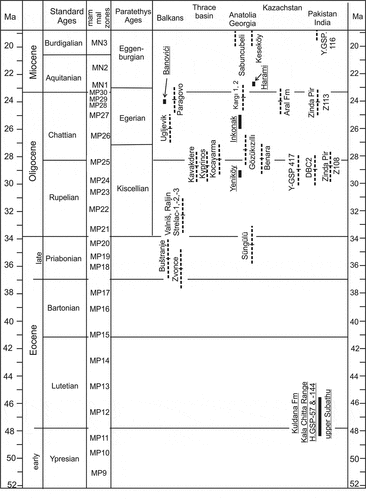
Table 9. Composition of the faunas found in Gözükızıllı-1a, −1b and Güvendik. Shown are the total number of first and second molars (M1/2) and the minimum number of individuals (N) as determined from the largest number of one of the dental elements. The cross indicates that no first or second molar has been found, but that the taxon is represented by another dental element
